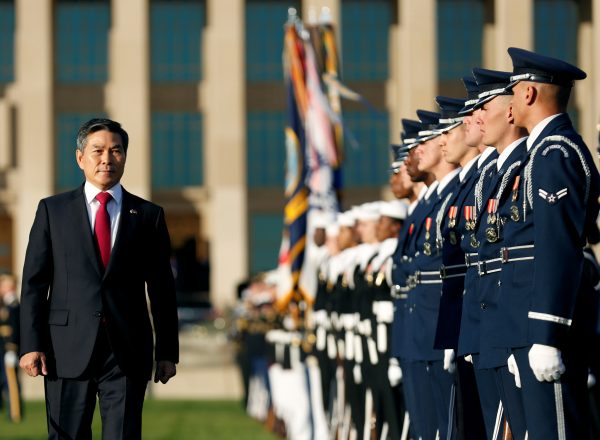Moon is attempting a long overdue reform of the Cold War-structured South Korean military, with a focus on the army and US alliance dependency. The moving of the Yongsan US military base from downtown Seoul is in its final stage with the completion of Camp Humpreys — the largest overseas US base in the world — now well outside the Seoul area.
Moon is pushing hard to complete the transfer of wartime operational control (OPCON) from US command to South Korean command under his term. The OPCON transfer attempted by former president Roh Moo-hyun caused controversy with conservatives not wanting to damage the US alliance, leading to its deferral. But President Trump’s calls for ‘America First’ and heavier burden sharing among international partners have spurred the Blue House into having another go.
The former Roh government also wanted to create a more integrated joint military posture, giving greater voice to the air force and navy. Now the military is downsizing its command and affiliated units, decreasing the number of generals from 436 to 360 and soldiers from 618,000 to 500,000. Most of the cuts are occurring in the army, raising the relative significance of the navy and air force. In 2018 two major army theatre commands were integrated, representing the biggest restructuring of the army since the Korean War.
To enhance joint operation, Moon first appointed a navy admiral and now an air force general as defence ministers, traditionally reserved for the army’s top brass. Moon has also strengthened civilian control of the military, with special investigations and a large shake-up of the Defense Security Command (DSC) and an increased number of civilian directors in the MND. Moon’s reforms are also driven by the looming shortage of military recruits due to South Korea’s demographic cliff, with the birth rate now having fallen under 1.0.
The consolidation of military forces is accompanied by the adoption of new technologies. The MND’s ‘smart’ reform plan aims to create a smaller but smarter military. Cutting-edge technologies are being introduced such as virtual reality (VR) and augmented reality (AR) to supplement the lack of training facilities, artificial intelligence (AI), and the Internet of Things (IoT) to better organise defence systems. Also set to be introduced are 3D printing technology for better fitting combat uniforms and drones for munitions transportation. South Korea wants to stay ahead in emerging military technologies made possible by the Fourth Industrial Revolution.
The Moon government ultimately aims to build a more independent strategic capability to meet the challenges of an increasingly uncertain Korean Peninsula. But at the same time, Moon wants to play a more active role in mediating peace between Washington and Pyongyang, the latter often deriding Seoul as ‘Washington’s puppet’. Without specifying North Korea, the MND plans to enhance Seoul’s ‘strategic target strike capability’, notably through new procurements including a reconnaissance satellite, mid and high-altitude surveillance drones and long-range air-to-surface guided missiles.
Seoul is also developing a ‘Korean-style missile defence capability’ by improving the performance of early warning radars for ballistic missiles, the Air and Missile Defense Cell (AMD–Cell), and the Cheolmae-2 medium-range surface-to-air missile (KM-SAM). For this, a total of US$58.8 billion is to be allocated to ‘secure the South Korean military’s strategic deterrence capabilities to respond to comprehensive threats’.
In March 2019 the air force introduced the first two F-35A fifth-generation stealth fighters from the United States. A total of 40 were ordered, carrying a total invoice of US$7 billion. Reports suggest there could be 20 additional orders. The new F-35A fleet will be augmented by new Global Hawk surveillance units and four air-refuelling tankers from Airbus.
For its ambitious reforms, the Moon government pledged to increase the defence budget significantly. According to the MND, the ‘medium-term plan’ for 2019 to 2023 will see the government allocate a total of US$242 billion to defence. That spending will see Seoul increase its defence spending by an average of 7.5 per cent year-on-year — well above the average rate of 4.9 per cent between 2009 and 2018. Moon has proposed an 8.2 per cent increase for 2019 to meet future threats, the largest since 2008.
Defense Reform 2.0 encourages a transition to a more effective and capable South Korean military force in the 21st century. But paying for a US$242 billion defence budget is not easy, especially with the rapidly rising cost of social security and sluggish economic growth. Seoul may need to start prioritising projects based on the relevance to a stronger defence posture. More importantly, how to reconcile the goal of a stronger and more independent defence stance while negotiating peace with North Korea remains an open question.
Dr Seong-ho Sheen is a Professor of International Security at the Graduate School of International Studies, Seoul National University.

